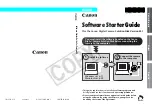
412
USING ACROBAT X PRO
Printing
Last updated 10/11/2011
Line screens
A.
65 lpi: Coarse screen for printing newsletters and grocery coupons
B.
85 lpi: Average screen for printing newspapers
C.
133 lpi: High-quality
screen for printing four-color magazines
D.
177 lpi: Very fine screen for printing annual reports and images in art books
The PPD files for high-resolution imagesetters offer a wide range of possible screen frequencies, paired with various
imagesetter resolutions. The PPD files for low-resolution printers typically have only a few choices for line screens,
usually coarser screens of between 53 lpi and 85 lpi. The coarser screens, however, give optimum results on
low-resolution printers. Using a finer screen of 100 lpi, for example, actually decreases the quality of your image when
you use a low-resolution printer for final output.
Specify halftone screen frequency
❖
In the Output panel of the Advanced Print Setup dialog box, do one of the following:
•
To select one of the preset screen frequencies and printer resolution combinations, choose an option from the
Screening menu.
•
To specify a custom halftone screen frequency, in the ink list, select the plate to be customized, and then enter the
lpi value in the Frequency box and a screen angle value in the Angle box.
Note:
Before creating your own halftone screens, check with your print service provider for the preferred frequencies and
angles. Also, be aware that some output devices override the default frequencies and
angles.
About emulsion and image exposure
Depending on the type of printing press used and how information is transferred from the film to the printing plates,
you may need to give your service provider film negatives or positives, with emulsion side up or down.
Emulsion
refers
to the photosensitive layer on a piece of film or paper. Typically, print service providers require negative film in the
United States and positive film in Europe and Japan. Check with your service provider to determine which emulsion
direction they prefer.
To tell whether you are looking at the emulsion side or the nonemulsion side (also referred to as the
base
), examine
the final film under a good light. One side appears shinier than the other. The dull side is the emulsion side; the shiny
side is the base.
B
D
A
C
Содержание 22020737 - Acrobat Pro - PC
Страница 1: ...Using ADOBE ACROBAT X PRO...
















































